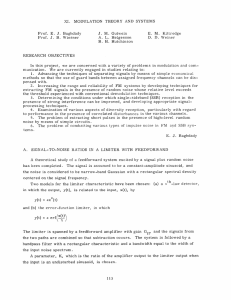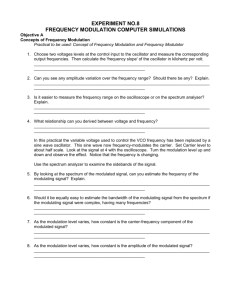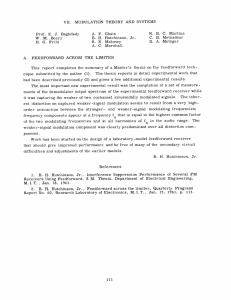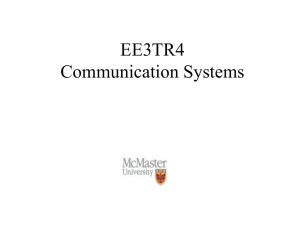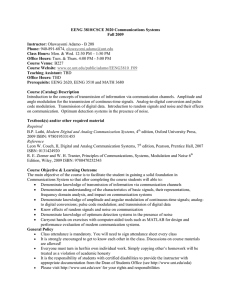MODULATION THEORY AND SYSTEMS XII.
advertisement
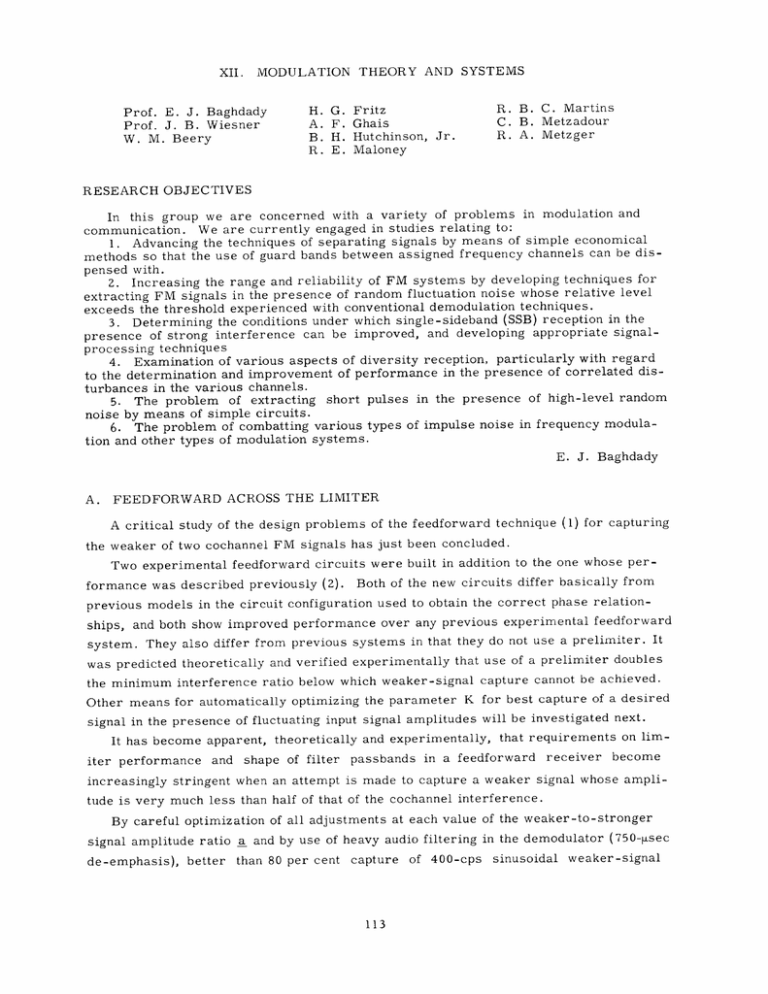
MODULATION THEORY AND SYSTEMS XII. Prof. E. J. Baghdady Prof. J. B. Wiesner W. M. Beery H. A. B. R. G. F. H. E. Fritz Ghais Hutchinson, Jr. Maloney R. B. C. Martins C. B. Metzadour R. A. Metzger RESEARCH OBJECTIVES In this group we are concerned with a variety of problems in modulation and communication. We are currently engaged in studies relating to: 1. Advancing the techniques of separating signals by means of simple economical methods so that the use of guard bands between assigned frequency channels can be dispensed with. 2. Increasing the range and reliability of FM systems by developing techniques for extracting FM signals in the presence of random fluctuation noise whose relative level exceeds the threshold experienced with conventional demodulation techniques. 3. Determining the conditions under which single-sideband (SSB) reception in the presence of strong interference can be improved, and developing appropriate signalprocessing techniques 4. Examination of various aspects of diversity reception, particularly with regard to the determination and improvement of performance in the presence of correlated disturbances in the various channels. 5. The problem of extracting short pulses in the presence of high-level random noise by means of simple circuits. 6. The problem of combatting various types of impulse noise in frequency modulation and other types of modulation systems. E. J. A. Baghdady FEEDFORWARD ACROSS THE LIMITER A critical study of the design problems of the feedforward technique (1) for capturing the weaker of two cochannel FM signals has just been concluded. Two experimental feedforward circuits were built in addition to the one whose performance was described previously (2). Both of the new circuits differ basically from previous models in the circuit configuration used to obtain the correct phase relationships, and both show improved performance over any previous experimental feedforward system. They also differ from previous systems in that they do not use a prelimiter. It was predicted theoretically and verified experimentally that use of a prelimiter doubles the minimum interference ratio below which weaker-signal capture cannot be achieved. Other means for automatically optimizing the parameter K for best capture of a desired signal in the presence of fluctuating input signal amplitudes will be investigated next. It has become apparent, theoretically and experimentally, that requirements on limiter performance and shape of filter passbands in a feedforward receiver become increasingly stringent when an attempt is made to capture a weaker signal whose amplitude is very much less than half of that of the cochannel interference. By careful optimization of all adjustments at each value of the weaker-to-stronger signal amplitude ratio a and by use of heavy audio filtering in the demodulator (750-[sec de-emphasis), better than 80 per cent capture 113 of 400-cps sinusoidal weaker-signal (XII. MODULATION THEORY AND SYSTEMS) modulation was achieved with a total distortion of between 8 per cent and 23 per cent over the range 0. 06 < a < 0. 9 under conditions in which signal and interference spectra overlapped completely. Performance fell off rapidly for smaller a. The heavy audio filtering used was found to favor the weaker-signal modulation frequency (400 cps) at the expense of other portions of the speech band. Use of a sharp-cutoff bandpass filter that is flat between 300 and 3000 cps seems to provide a much better compromise for speech transmission and yields single-frequency minimum distortion figures closer to 20 per cent than 8 per cent (a = 0. 5) with increasing distortion for smaller a. Extensive tests of distortion and capture versus weaker-signal modulating frequency over the speech band 300-3000 cps for a wide range of different types of stronger-signal modulation were conducted, as well as tests with reduced deviation on each signal, with a = 0. 5. With this interference ratio, the total distortion on the captured weaker-signal modulation ranges generally between 15 per cent and 30 per cent; the exact value of distortion is a function of weaker-signal modulating frequency, type of stronger-signal modulation, and deviation of each signal. A few qualitative speech-intelligibility tests were conducted with the 300-3000 cps bandpass filter in the demodulator and voice modulation on the weaker signal with a = 0. 5. With all of the various deviations and types of interfering modulation, the H. Hutchinson, Jr. speech modulation was generally completely intelligible. B. References 1. E. J. Baghdady, Quarterly Progress Report' tronics, M.I.T., Oct. 15, 1957, pp. 52-55. Research Laboratory of Elec- 2. B. H. Hutchinson, Jr., FM reception with coherent interference and random noise, Quarterly Progress Report No. 57, Research Laboratory of Electronics, M.I.T., April 15, 1960, p. 87. B. THE OSCILLATING LIMITER A research study has been concluded on several models of the oscillating limiter in order to measure and evaluate the signal-to-noise ratio improvement that can be achieved with simple circuits. Measurements were made under various conditions to show how the performance of such devices improves the FM noise threshold. Our basic idea was to use simple and economical circuits. Several circuit arrangements in which both a conventional pentode limiter and the gated-beam 6BN6 tube were used were built and tested. Conventional i-f frequencies of 455 kc, 4. 5 mc, and 10 mc were chosen. The results show a better performance for the oscillating limiters built around a 6BN6 limiter than for the pentode limiter. Small phase shifts of appromimately 1" at 114 (XII. MODULATION THEORY AND SYSTEMS) ±50 kc deviation from the center frequency were possible with the 6BN6 limiter; this phase shift permits higher values for the ratio of the feedback oscillation voltage Eose to the signal voltage E s . The basic theory (1) predicts - and it has been confirmed by our measurements - that high values for this ratio are desirable for high S/N improvements in this device. The maximum value of Eosc/E s is bounded, however, by the max- imum phase shift around the loop so that the FM signal may suppress the oscillation over its entire deviation cycle. The effect of increasing noise on the locking range of the oscillating limiter was also studied. It was found that the oscillating limiter is able to lock any signal that sat- isfies the locking condition mentioned above if E osc has a high enough value to produce adequate quieting at the demodulator output, even though the signal itself may be buried in high-level noise. No exact quantitative measures were made, but a series of pictures was taken that proves this statement. In the models tested improvements of more than 10 db in the S/N ratio with the use of this device were recorded, even for low values of Eosc /Es around 5 or 10, and for S/N ratios from the i-f section of approximately 13 db. This represents a considerable improvement in the message extractability and reliability of the system over that of a conventional FM receiver. Another series of measurements shows that the oscillating limiter is capable of efficiently reducing the FM noise threshold. In these measurements a very good FM demodulator that consisted of a frequency discriminator preceded by three narrow-band limiters having an over-all noise threshold in the vicinity of 10 db was used. The audio output had provision for switching from a 3-kc lowpass filter to a lowpass filter at approximately 20-kc cutoff. Reductions in the noise threshold of approximately 12 db were possible with deviations of ±5 kc. With deviations of ±20 kc, the system showed noise threshold improvements of approximately 6 db. Further research is being carried on so that greater improvements in the noise threshold can be ontained with even greater deviations. Because of practical considerations it was also found that the models operating at higher frequencies were capable of giving better performance than those built at 455 kc. R. B. C. Martins References i. E. J. Baghdady, A technique for improving detectability of FM signals, Lectures on Communication System Theory, edited by E. J. Baghdady (McGraw-Hill Book Company, New York, 1961), pp. 540-546. C. SIGNAL-TRACKING OSCILLATOR A locked-in oscillator was built and tested as a means for achieving improvement in the signal-to-ncise ratio for FM receivers. It is basically different from the normal 115 (XII. MODULATION THEORY AND SYSTEMS) phase-locked oscillator. It performs as a highly selective filter for the frequency of the signal to which it is locked. of the incoming signal. The same system can also be made to lock to subharmonics Advantage has been taken of the fact that the system cannot be locked to the noise because of its inherent incoherency. Several experimental models have been built for conventional frequencies and tested to relate locking ranges and improvement in signal-to-noise ratio to the ratio Eout/Ein' for different working conditions of the device. Measurements were performed that showed the possibilities of the system. From these measurements, it seems to be pos- sible to achieve approximately 20 db improvement in the signal-to-noise ratio. 16-kc deviation and an intermediate For a frequency of 4. 5 mc, an improvement of threshold level of 8 db as compared with a normal FM system was found C. 116 B. Metzadour
